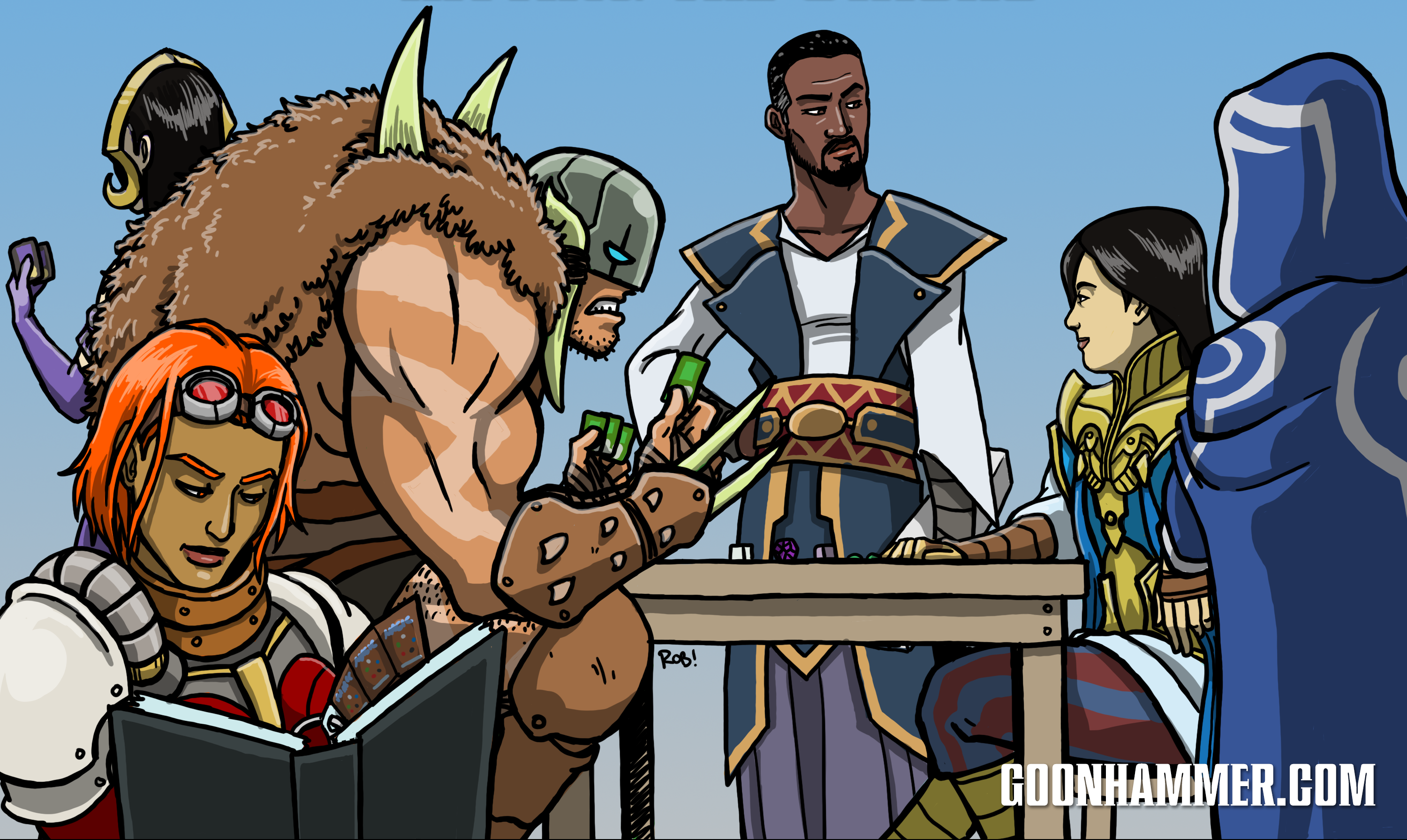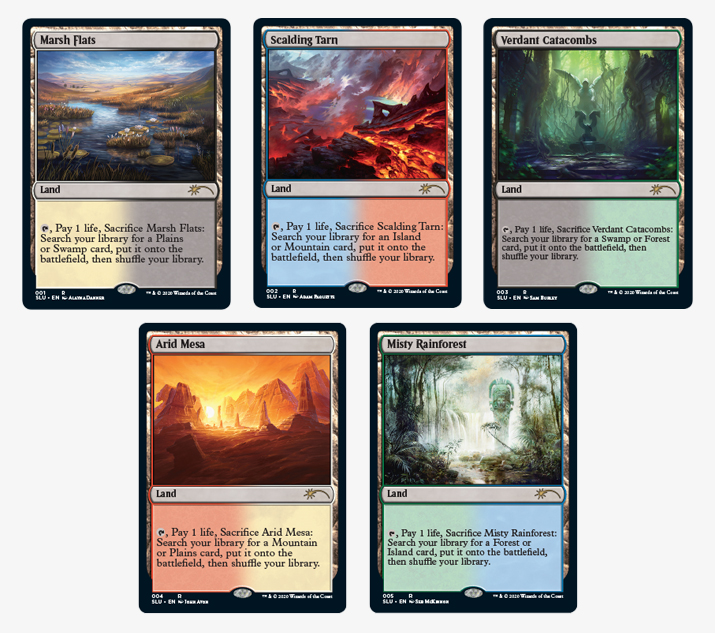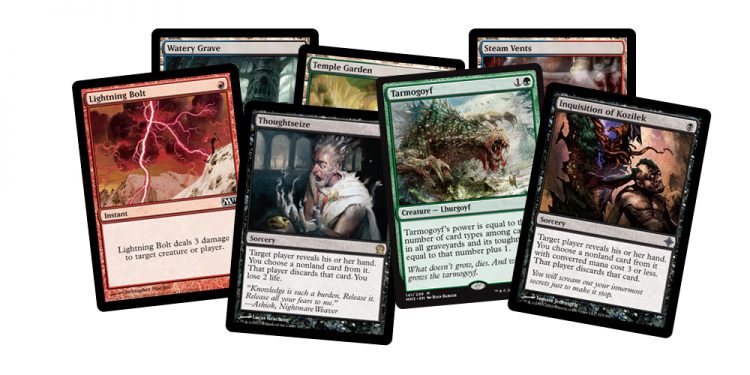Modern was created in the summer of 2011 as an eternal format that had a starting point later than the Limited Edition Alpha and Beta sets from 1993. At nearly 14,000 cards and counting, Modern is the largest eternal format that does not include cards on the reserved list. Its legal sets stretch as far back as 2003’s Eighth Edition Core Set. Every card that is legal in Modern has the potential to be reprinted in a future Standard-legal set or supplemental set.
Modern’s depth allows for many different play styles and budgets. Decks across the spectrum of archetypes exist in Modern and there is always an option for any player at any skill level. Modern is a brewer’s dream with a deep enough card pool to experiment with nearly anything. At your local scene, you can compete with decks that barely cost a thing. If you have been playing Magic for a number of years, you will likely have something to start your first Modern deck with from your old Standard decks or transition to a larger eternal format with what you have been playing with in Pioneer.
Links to Know
Modern-legal sets and ban list
Modern banned cards on Scryfall
A Brief History of Modern
There are two things that define the history of Modern—Extended and the Reserved List.
8th edition was chosen as the starting point for Modern because it marked the beginning of a sea change at Wizards in how they designed Magic sets (as well as a change in the visual design of cards). Expansions were no longer set on the plane of Dominaria like they had been for most Magic’s early history. Blocks would take place on different planes in the multiverse and would sometimes reference characters or events from Dominaria that had an impact on that plane. The new frame design served as a useful reminder for players of what cards were legal in the new format. While reprints of cards in auxiliary products like Duel Decks, Planechase (2009), and Commander (2011) contained reprints of cards that were in the new card frame but not legal in Modern, the format’s card pool was still easily recognizable.
Before the creation of Modern, a rotating format called Extended was the format that was placed between Standard and Legacy. The format did not originally rotate yearly, instead having older sets removed once enough expansions were added to the format that Wizards would decide to shed the oldest blocks. In 2008 with the release of Shards of Alara, Wizards set a yearly rotation schedule for Extended that occurred at the same time as Standard. The format reached as far back as the last seven years’ worth of expansions. The format’s breadth was cut down to only four years in summer 2010. Extended was never very popular among players and interest in it only arose during the Pro Tour qualifier season that used Extended and when a Pro Tour would use the format.
Shortly before the change in the Extended format’s card pool, Wizards also tightened its policy with the Reserved list. The Reserved list is a list of cards that Wizards promised it would never reprint in 1996 after controversy among game stores and collectors with the release of Chronicles the year prior. Wizards has added and removed cards from The Reserved over time, with the last major update happening in 2002 before the release of Onslaught, where commons and uncommons were removed from the Reserved list and no cards newer than 1999’s Urza’s Destiny would be added to it. Wizards gave itself leeway to reprint cards on the reserved list as premium foils. These reprints were always in limited quantities and usually only given to judges as promotional cards. This policy was again revised after some outcry around foil reprints of Reserved List cards and no reprints of any cards on the reserved list have been made since 2010.
When the Reserved list policy changed, there were rumors of an eternal format that excluded cards from the Reserved list being developed. Mercadian Masques was rumored to be the starting point of this new format since it was the oldest Magic expansion to feature no cards on the Reserved list. A year later, Modern was announced with an aggressive banlist that quickly grew in its first few months. The format’s banlist was informed on the 2010 Extended PTQ season and grievances from eras in Standard in the years before 2011. Extended was formally retired in 2013 and Modern has been going strong ever since.
Getting Started
But where do you start? Browsing Modern decklists online will probably lead you to looking up the cost of singles for that deck, and many of them will seem insane. “No way can I afford a Scalding Tarn! It’s eighty bucks!” Modern-legal staples can be expensive, especially for several lands and other cards that haven’t seen a reprint at all or in a long time. If you’ve ever seen the Modern players at your local scene, you’ll wonder how they were able to afford those cards in the first place.
There’s scene in the movie Gran Torino with Walt (Clint Eastwood) and Thao (Bee Vang) where Walt is trying to help Thao with some life lessons and later helps get him a job at a construction company.
THAO
“Okay, what’s this?”
Thao points to a tool.
WALT
“Post hole digger.”
Thao starts pointing at things on the workbench in quick succession, questioning Walt with his expression.
WALT
“Hand spade. Tin snips. Nail punch. Tack hammer. Putty knife. Wire stripper. Drywall saw. Tile spacers.”
Silence. Walt can see something is bothering Thao, but he’s too uncomfortable to speak up.
WALT
“What?”
THAO
“I can’t afford to buy all this stuff.”
WALT
“I didn’t buy all this stuff at once, blockhead. I’ve lived here for fifty years. A man stays in one place long enough he tends to attract a decent set of tools.”
As you accumulate cards and continue playing Magic, you’ll have cards rotate out of Standard. Once the years add up, you’ll have a lot of cards that are unplayable in Standard. It would be wasteful to throw your old cards into the trash. You can sell them or trade them as they rotate out, but someone’s going to be holding all those old cards. The eternal formats like Pioneer and Modern provide a space for veteran players to play with their old cards. The eternal formats also draw from a much larger card pool. The pipeline for getting into Modern usually begins with a player moving on from Standard to an eternal format. It’s rare for a new Magic player to begin playing in sanctioned tournaments that are eternal formats. Not very many Magic players have a thousand dollars lying around that they can spend on a Modern deck without issue. They built those decks and their collections up over time.
As a new Modern player, you’ll want to have a launching point. Look at the cards you have now and see if any of them have a home in Modern. Use what you have in your collection to guide you into your first deck. Then set yourself a budget. There might be a deck you have no cards for already, but it appeals to you and is cheap. You might have a playset of a card that’s expensive that’s also in a Modern deck and cuts off some of the cost of the deck. Once you commit to a deck within the budget that you’ve set, begin acquiring the cards you need.
Patience can sometimes pay off and a juicy reprint set will come along. 2020 has been a particularly loaded year with reprints. Mystery Booster, Jumpstart, and Double Masters are full of reprints of powerful cards in Modern. Even Core Set 2021 was seeded with many reprints of powerful Modern-legal cards like Ugin, the Spirit Dragon and Azusa, Lost but Seeking. A major reprint will cut down the cost of singles as new supply circulates. The cost of packs for these reprint sets are often higher than regular expansion sets—sometimes as high as $14 per pack. You might pick up a pack or two on a whim or spring for a draft, but it is still best to collect the singles you want through trade or purchasing the cards from a seller.
When I began playing Magic again in 2016, I was already a veteran player and wanted to return to Modern very quickly. I started playing Standard by finding a deck I could build for about $200 or less, then settled on a Modern deck to build up towards. I knew that I wanted to play a Blood Moon deck, and a mono-red Blood Moon deck called Skred Red was an established deck that would only cost me about $300 to build—half of the cost being the set of Blood Moons. I built up my store credit by trading in my prize packs from FNM to make the monetary cost easier to bear and pieced the deck together with what was available at my local store and with deals I found online. I had the deck assembled in a month and started playing with the Modern crowd and never looked back at Standard. My second Modern deck was also a Blood Moon deck, so I had already reduced the cost of my next deck significantly. I did the same thing I did when putting together Skred Red and built up store credit to use on singles available locally and jumped on sales and other good deals online.
What Defines Modern?
Efficiency is the defining trait of Modern. In Standard, burn spells like Shock and Lightning Strike are the baseline.
In Modern, Lightning Bolt is the baseline. A discard spell like Duress wont’ see play in Modern because Thoughtseize and Inquisition of Kozilek have greater reach for the same mana cost. The power creep of Magic has emphasized creatures with strong enters-the-battlefield abilities, but they’re even more important in Modern where the removal is so much more efficient.
A creature that can only attack and block needs more than high power and toughness; it needs to come at a cheap cost. Despite the setup Tarmogoyf requires to be 4/5 or better, fetchlands and cheap spells grow Tarmogoyf quickly enough that even on turn two it can be 3/4 or 4/5.
Lands in Modern also need to be efficient for any deck stretching into even two colors. In Standard, you must make do with whatever is available. There is not a lot of tolerance in Modern for dual lands that enter the battlefield tapped. The shocklands are the standard dual land in the format, where fetchlands can search for them and fix your mana on turn one. Even if you are starting your game down three life to pay for the fetchland’s cost and the two life to play the shockland untapped, establishing your colors on turn one will open up your access to your manabase right away. Other dual land cycles such as the fastlands make getting to all your deck’s colors possible in the early turns without eating as much of a loss of life.
Interactivity vs. Linear
Modern’s playstyle typically falls into two paths—interaction or linearity. A common criticism of the format is that it’s a linear format and interaction is not possible. This is likely going to be the argument of the format’s quality for the rest of its life, but it’s difficult to define because players have different playstyles and readings on what these things mean.
Interaction in Magic comes down to your cards affecting your opponent’s cards and your opponent’s cards affecting your cards. Your plays have a bearing on the game. Linear gameplay tries to completely ignore its opponent and fulfill its win condition. Just follow these steps and get the game over with.
Games that are very interactive tend to be more fulfilling experiences for both players. It makes for a far better story about all of the interactions that you and your opponent went through before you could pull off your win or how you were narrowly defeated instead of describing how you got your combo off in ideal conditions. Sports matches with a lot of back and forth are also more entertaining to watch instead of one team rolling over the other.
There are a lot of “non-games” in Magic where you will be paired up against an opponent that just manages to completely roll you over. It could be because they were able to draft a strong deck, your deck in your format just gets paired up against something it has a bad matchup with, or you hit some bad luck and the critical pieces of your deck were just never able to come together. Even the best players are just at the mercy of variance. Modern has a large enough card pool that many different combo decks exist that can completely ignore their opponent and play a game of solitaire until they win. You have to compose your sideboard to account for as many different matchups as possible, but fifteen cards are just not enough to cover all of your bases for games two and three. The tools in Legacy that can be played in game one like Force of Will and Daze aren’t in Modern, and even if you have the interaction for your opponent, it will be a matter of having it at the right time and being able to use it. It is frustrating to be on aggro and be totally helpless against a combo deck like Storm. Your opening hand in your tempo deck might have enough interaction against an aggro deck to deal with three creatures, but you’ll be committing all of your resources into keeping the board clear instead of dictating the pace of the game and establishing your own board and getting beat by that fourth and fifth creature.
Next Time: The Staples
In part two of this series, I will cover the staples of Modern. The format is huge, but many cards stand above the rest for their power and universal usage. You’ll need to consider acquiring those cards for your growing Modern collection, and several have overlap with Pioneer or Legacy.
Have any questions or feedback? Drop us a note in the comments below, or email us at contact@goonhammer.com.





